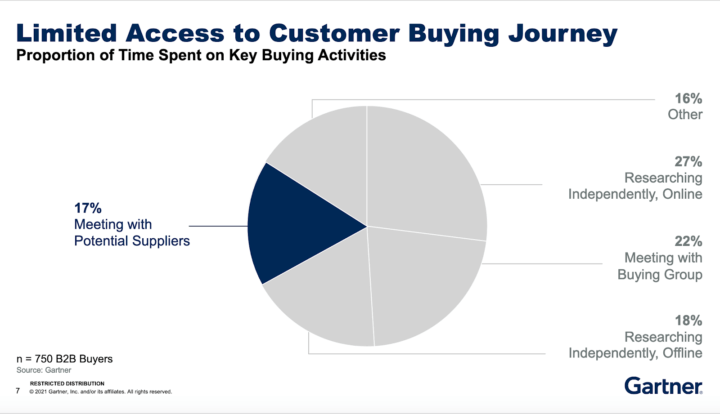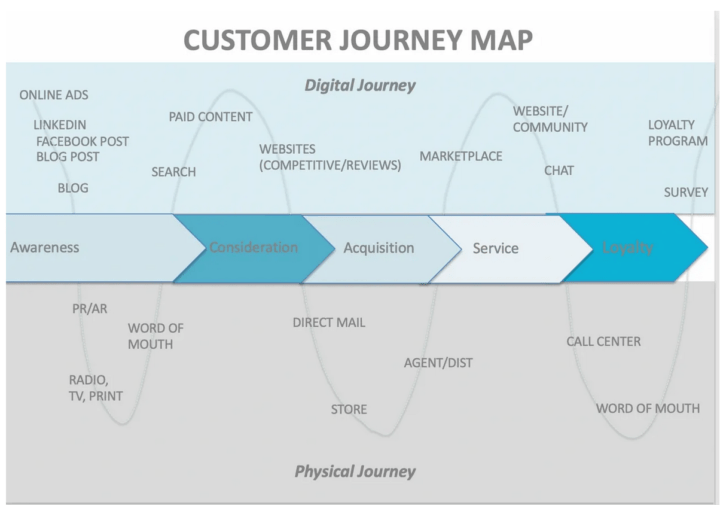Turbocharge Your B2B Digital Brand – Part Two

By Janice Roberts
In our first post we spoke of the sea change taking place in B2B buying habits today, as customers fully embrace a digital reality and the new norm of researching and buying online.
In case you still question these changes, you may be interested to learn:
- Gartner’s Future of Sales 2025 report predicts that by 2025 80% of B2B sales interactions between suppliers and buyers will occur in digital channels. Even now, in 2021, we know from Forrester Research 68% of buyers prefer to gather information online themselves.

- Conventional marketing methods – advertising, print, even on-site events and meetings have gone the way of the dinosaur in the midst of a worldwide pandemic. TOPO, a division of Gartner, reports buyers typically only spend 17% of their time meeting with potential suppliers when considering a purchase.
- Millennials, 73% of whom participate in B2B buying decisions (a third of the time being the decision maker!) prefer to conduct research and the journey on their own. They typically identify their need, explore solutions and determine requirements, before then choosing a supplier and even validating their decision online.
There can be no doubt a customer-focused, streamlined digital experience presents a possibility for greater brand success.
In this blog post, we’ll cover the remaining 5 brand elements for success (numbered 6-10 below). I’ve included the first five also for context, once more:
- Selecting a company name
- Securing an online presence
- Create and establish a visual identity that is modern, compelling, memorable, and resonates with your target audience in early testing.
- Identify and document target customer personas
- Focused messaging; informed by the personas, underlining the differentiated benefit
- Understand and document the Customer Journey
- A website and content management strategy that enables a successful, seamless buyer’s journey
- Connects with your target persona
- Enables a successful, seamless journey
- Social media profiles aligned with your web presence to further promote your brand and augment your strategy, and a plan for consistent engagement
- Customer proof points for credibility
- Measure, rinse, repeat
And for a more detailed perspective:
6. Understand and document the customer journey
Today there are tools and software that document the entire journey a customer will take to purchasing a product such as the one you offer. This can be extremely complex (Gartner has a “spaghetti graphic” offering a testimonial to the complexity of some B2B decisions) and it can cross over between digital and physical touchpoints.

But even at a basic level, understanding of your buyer’s journey can help immensely in designing a website, a product, and a seamless customer experience that will be successful for both your prospect and your company.
Again, to establish this understanding and document your findings start with those most knowledgeable within your organization – for example Sales Support, or Customer Experience, or any former customers who are now on the team. But then cross-check your findings with actual customers, if possible, in interviews.
Last year, in the midst of COVID, Gartner analysts told a C-Suite gathering that if they hadn’t updated their customer journeys in the past 6 months they were now out-of-date. Is your understanding of the pivotal moments, the assets reviewed, the websites visited, the online and offline events attended current? Or does your understanding of this process need a refreshed view?
7. A website and content management strategy supporting the buyer’s journey
With the target persona in mind, and an idea of the content required by your ideal customer, you can now design an engaging website that offers answers to key questions, facilitating a smooth customer journey and enabling them to solve their problem.
Excellent product information, supporting insights, current research and “how-to” roadmaps are all part of the answer. Your website and content strategy should build your brand while simultaneously enabling your prospect to recognize and define their problem, design a solution, research that solution and ultimately solve their problem.
Are you investing to enable prospects to conduct a smooth and successful journey? And remember, great content goes way beyond data sheets and product-specific info. These are typically the least-leveraged content on a vendor website.
Instead, whatever you can do to
- Further their understanding regarding the problem; clarifying their need (perhaps clarifying the issues in their own minds)
- Enable the customer to understand their return on investment
- Show them what others have done before them to solve like-type problems (case studies) and industry best practices (research, experts and analysts offering proof points).
All of these assets provide credibility and value to your prospect, in turn building your brand in the eyes of customers.
8. Establish social media profiles and engage prospects /stakeholders
Brand building today is not complete without an active presence on social media: LinkedIn, Twitter, Instagram, YouTube and FaceBook for many. Reddit, TikTok, Quora and SlideShare for others, depending on where your stakeholders are engaged and hanging out.
Engagement for a brand is not just posting but following, listening and responding.
Select your platforms carefully. Unless you have extensive resources dedicated to Social Media, most brands cannot support active engagement on more than 2-3 platforms.
A social strategy, that reflects your brand values, authentic participation in topics of interest to your customer and you, should be at the heart of your social activities. In 2021 increasingly brands have been called on to show empathy, to support causes such as social justice and humanitarian support, to stand behind their values and beliefs. It is a fine line, but a rewarding one for the brand who navigates social strategically.
9. Customer proof points
For almost any product or service, customer advocates from your current active user community are invaluable. Their quotes, reviews, case studies and testimonials can be a boon for growth, or the cause of massive headaches and upset online.
Cultivate advocates. Have a strategy to acquire and broadcast their support digitally, whether that is via third-party websites like Capterra, G2, or the Amazon Business Marketplace, or via your own website.
Customer proof points are an essential part of any B2B flywheel. Get it in motion to build your digital brand strength!
10. Measure, rinse, repeat
There are many measurements that can point toward progress, provide lead generation and conversion insights, or enable you to better understand your customers and the progress you are making.
Traditionally, B2B marketing has done a not-very-good job of tracking and monitoring the data that explains how well investments are faring. But there are many tools today, extracting from the literally thousands of software programs on the MarTech platform, including free tools like Google Analytics, that can be employed to measure reach, engagement, conversion, and qualified leads, to name just a few.
Take steps to improve digital trust and credibility
In 2020 the CMO Council reported 9 of 10 B2B buyers said online content had a moderate to major effect on purchasing decisions. Not only will it influence buying decisions, your website, your content, your digital presence directly impacts the perception of your brand and the perceived success of your company. It’s time to address the elephant in the room and make sure your Digital Brand is everything you desire.
These steps are a starting point! From here, you will add SEO and a blog, begin expressing your brand voice for greater engagement and growth. Let us know how you are doing!

Janice Roberts, formerly of Belmont Shore, misses life in Long
Beach! Now based in Northern California, she is co-founder of
AscendX Digital, a digital commerce consultancy focused on
helping B2B clients deliver best-in-class digital brand
experiences and excellent product information that converts
eCommerce shoppers to buyers.
A long-time tech marketer, with experiences ranging from start-
up to tech giants, you can subscribe to more of Janice’s thoughts
and marketing advice at AscendX Digital, on Twitter
or reach her directly at janice@ascendxdigital.com.
